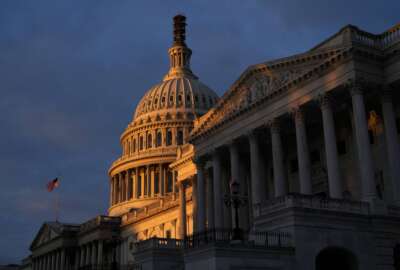
Mikulski looking for ‘bonus money’ for NIH, appropriations for federal pay raise
Sen. Barbara Mikulski (D-Md.) said she is spending at least part of her last year in Congress advocating for more money for science and medical research, and for an...
The longest-serving woman in Congress promised during her last year in office that she would work to find “new money” and “bonus money” for the National Institutes of Health to help meet its mission, as well as continue to work on a proposed 5.3 percent pay raise for all federal employees.
Sen. Barbara Mikulski (D-Md.) said she would “work my earrings off that the last appropriations for the NIH under Barbara Mikulski’s watch is going to be the best damn appropriations you’ve ever seen.”
“Do no harm. What do I mean by that? No sequester, no shutdown, no slamdown, let’s get our job done. You do your job, we need to do our job,” Mikulski said during a speech at NIH in Bethesda, Maryland. “Capitalize existing programs. You’re all doing great work. We need to make sure what you’re doing gets funded. You need something that’s realizable, undeniable, sustainable; don’t screw around, keep going, and that’s exactly what we’re going to do. We’re also going to see if we can find new money for our new ideas and some of the ideas that are already on the books: the [Brain Research through Advancing Innovative Neurotechnologies] Initiative, precision medicine. Let’s not forget our young investigators. But let’s look at where we can find bonus money, called mandatory funding, to make sure you even get a bigger shot at the [Cancer] Moonshot, or all the other great things that you’re working on.”
Mikulski announced her retirement in March 2015. Her fifth term in office ends January 2017. She was elected to the House of Representatives in 1976 and took office in the Senate in 1987.
Mikulski is currently the vice chairwoman of the Appropriations Committee.
The senator said when she first came to NIH, “we didn’t even know how to spell the word ‘genome,’ let alone race to be able to map it.”
“My single goal was to let you be you, so you could come up with the cures and the breakthroughs, the new ideas, the new science that would help the American people and people all around the world,” she said.
NIH has requested $33.1 billion for fiscal 2017, an increase of $825 million over the enacted fiscal 2016 budget.
Included in the request is $680 million for the National Cancer Moonshot, to speed up the progress toward finding a cure for cancer. The BRAIN Initiative is looking for $195 million, while an additional $26 million has been requested as part of total pay costs.
“The FY 2017 President’s Budget would provide $3.6 billion for [Intramural Research], which is $33 million more than the FY 2016 Enacted level,” budget documents state. “It accommodates required pay cost increases for federal civilian employees and military personnel as well as employer-paid health insurance premium adjustments.”
The NIH employs about 18,000 people at its Maryland location.
Mikulski recently added her name to the Senate version of the Federal Adjustment of Income Rates (FAIR) Act, which would give federal employees a 5.3 percent pay increase.
Sen. Ben Cardin (D-Md.) is also supporting the pay increase. Cardin said the pay raise would help quell the ongoing fight about locality pay.
“Locality pay doesn’t make a lot of sense,” Cardin said during a March 7 town hall meeting with employees at the Food and Drug Administration. “It doesn’t. There are people who live in higher cost areas that are not getting that than people who live in the areas that are getting it. What we’re trying to do is get a review of this in an objective sense to make the pay more realistic to the needs.”
A House version, introduced by Rep. Gerry Connolly (D-Va.) is gaining support in that chamber.
Mikulski told Federal News Radio that she was continuing to work on the pay increase “as we work on our overall allocations.”
“From the federal employees, they’re all advocating among members that we get the kind of allocations we need to do this,” she said.
When the government closed in 2013, 80 percent of its employees — including doctors and researchers working at agency laboratories and at the NIH Clinical Center in Bethesda — went home.
Some patients were turned away and employees spent thousands of hours closing down laboratories and setting aside research, said NIH Director Francis Collins late last year.
Collins said NIH lost $1.5 billion in research funding in 2013 and he’s lost some experienced doctors and researchers to work for other institutions abroad.
Copyright © 2025 Federal News Network. All rights reserved. This website is not intended for users located within the European Economic Area.




